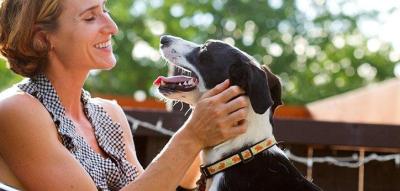
How to Stop Dog Mouthing
If you watch dogs play together, they often mouth each other in a sort of mock bite. Many dogs play with people in the same way — by mouthing our hands or other body parts. Although mouthing is not dog biting, there can still be enough pressure where it is painful or can accidentally break skin.
Why dogs mouth
Dog mouthing is a natural behavior that generally occurs during play or when a dog is feeling overexcited. Puppies can be especially mouthy because part of the way they learn about the world is through their mouths. Plus, mouthing can be satisfying for a teething puppy.
However, as puppies grow up, they should learn through cues from people and other dogs that they must be gentle. When dogs mouth each other during play, sometimes one will yelp if a bite is too hard. This helps teach them bite inhibition, or how hard to bite in order to not break skin or cause pain.
Home starts with you
Steps to teach a dog not to mouth
Teaching a puppy and teaching an adult dog will utilize different tactics. Puppies are learning bite inhibition, and with adult dogs you are working on teaching them appropriate play.
Puppies:
- If you are petting your puppy and they start to mouth, say “Ouch!” in a loud, surprised tone, and remove your hand (or other body part) from the dog’s mouth. Try to avoid jerky movements, as a dog can see those as part of the game. Instead, take your hand away, and leave it neutral at your side or behind your back.
- Wait a few seconds for your dog to calm down, and then reach out to pet them again. If the dog mouths your hand again, repeat the steps above until the mouthing stops.
- When the dog does not mouth your hand, offer praise and introduce a toy. You can then throw the toy and say “get the toy” to start a game of fetch.
Adolescent/adult dogs:
The steps for an older dog are similar to those for puppies, but you do not need to react or say anything if they begin to mouth you.
- Keep a toy handy, and if the dog starts to mouth/bite at your hand or other body part, quickly give them a toy to play with and engage with them. Make sure you are actually playing with them and not just giving them the toy to entertain themselves.
- If they continue to mouth you, go neutral and stop engaging. You can give them a verbal marker “uh-uh” as they mouth as well. Once they stop, you can calmly reward them by petting.
- Some dogs will have a hard time disengaging and will continue to mouth and potentially get more aroused. If this is the case, remove yourself from the situation and wait for them to settle before attempting to engage again.
Consistency is key
For a dog to get the idea that mouthing is not acceptable, they will need lots of practice with the above technique. As with other dog training techniques, consistency is key, so make sure that anyone who interacts with your dog knows how to discourage mouthing. Never give mixed signals by allowing mouthing on some people but not others.
